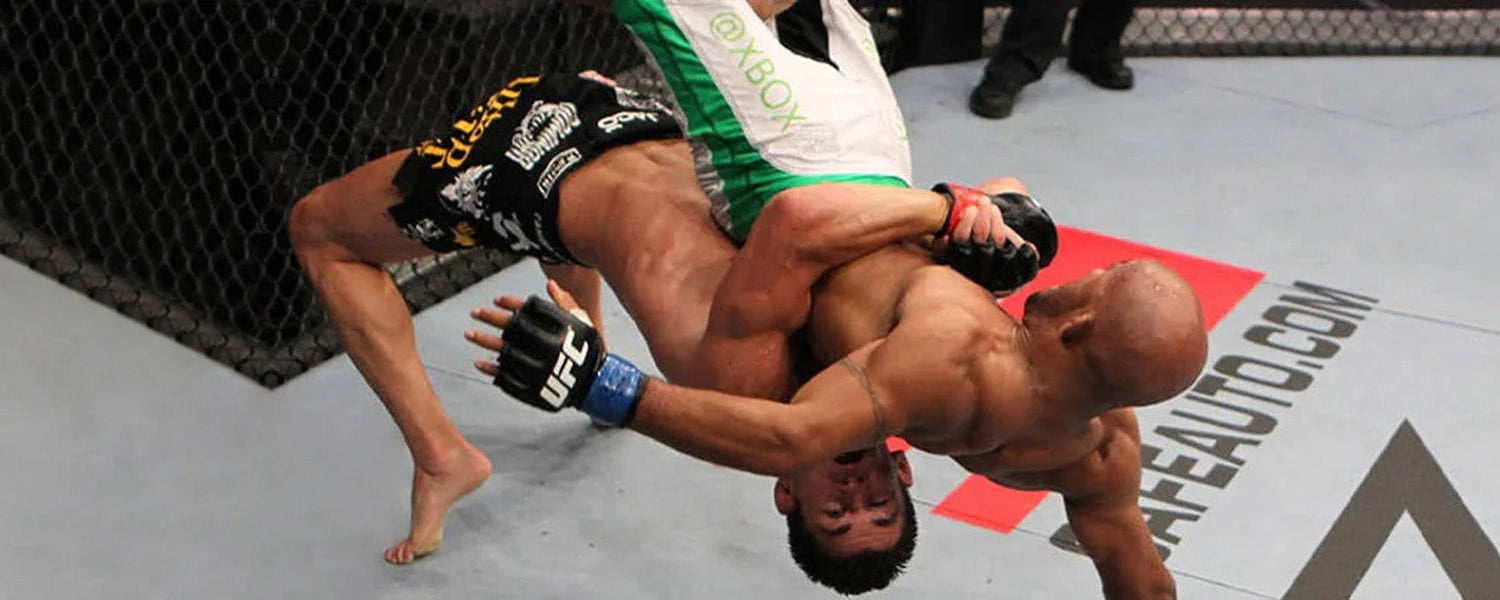Table of content
Mixed Martial Arts, also known as MMA, is a combat sport that gained and is still gaining popularity. This sport combines multiple arts, including boxing, Jiu-Jitsu, wrestling, kickboxing, and many more.
However, one particular move has been under scrutiny in MMA, which is suplex. This move in MMA started controversy and is still being enthusiastically discussed among the fans and players of MMA.
Some in MMA argue that it is dangerous for players and cause severe injuries, while others say it is a legitimate technique. But still, the question pops up, is a suplex allowed in MMA?
You can start by understanding what suplex is and examine the reasons for its ban in MMA. There will be a section of suplex types to make you completely aware of this move.
Also read: What Is Suplex? How Can You Do It Perfectly?
1. What is Suplex?
Suplex is one of the most offensive moves in wrestling. It is a wrestling throw that involves grabbing your opponent around the waist off the ground and throwing him over your shoulder. So, he slams on the mat.
Suplex is a deadly technique used to display the strength and athleticism of the player. Each MMA player uses a unique style to perform this technique.
Hence, it can be completed in multiple ways, and players can even invent their unique style to perform the suplex. Some popular variations of this technique include fallaway suplex, package fallaway suplex, fisherman fallaway suplex, and so on.
Some players apply a quick and forceful approach to perform suplex, while others take their time and make a calculated move. An important thing to note here is that only a player’s focus, timing, strength, and correct technique can guarantee the successful application of a suplex.
2. Is It Allowed In MMA - 5 Reasons Why

2.1. Risk of Serious Head And Neck Injury
Suplex is risky, involving lifting the opponent and throwing him on the mat or ground on the neck or head. This move leads to serious head, neck, and spinal cord injuries, concussions, and even a player’s death.
Without any doubt, MMA is a combat sport, but the safety of the fighters is still a top priority, as it should be. Therefore, the organizers banned all such moves that pose a significant risk of injury, and suplex falls into this category.
2.2. Unfair Advantage Over the Opponent
The fighter who can perform suplex gets a significant advantage over the other fighter in the ring. This move is so powerful because when you use it and slam a fighter to the ground, it can cause them to lose consciousness.
In the worst case, the fighter who suffers the slam becomes disoriented, allowing the other fighter to capitalize on it to their advantage. It is against the spirit of MMA and makes the fight unfair.
2.3. Difficulty Regulating
Suplex is a highly complex move, so it is tricky for the MMA organizers to regulate. To perform this technique, you must acquire a high degree of skill and style to execute it safely.
Most fighters lack that proficiency and that is why it’s tremendously difficult to perform this move without hurting someone badly.
Due to its complexity, judging whether the suplex is performed safely or dangerously is challenging, which leads to controversy.
2.4. Liability Implications
In MMA, the use of suplex raises liability concerns for promoters and organizers that host the event. In some jurisdictions, if a fighter uses the move might face legal consequences, and also, disciplinary action could take place by MMA.
Organizers of MMA strictly implement this rule because promoters and organizers would have to face lawsuits if a fighter is seriously injured or killed due to a suplex. Therefore, suplex is completely banned in MMA to protect the sport’s integrity and the player’s safety.
2.5. Ethical Considerations
If MMA allows suplex, it can negatively impact the sport’s reputation and credibility. Though MMA is a combat sport, it should not cause serious harm to participants.
Suplex can potentially cause severe damage, and if any incident happens, it will implicate that MMA is condoning or promoting violence. It can discourage the fans and may lead to a decline in the sport’s popularity.
Keeping that in mind, banning the suplex is a great decision to maintain the integrity and ethics of the sport.
3. 10 Types of Suplex Move
Suplex is one of the most brutal moves in wrestling and MMA fighting, and numerous ways exist to perform this move. Here’s a brief description of some of the most commonly used suplex moves:
3.1. German Suplex
The German suplex move involves grabbing your opponent from behind, lifting him up and over your head, and slamming them backward on the ground.
3.2. Belly-to Belly Suplex
In this suplex move, you need to grab your opponent around the waist, lift him up and backward, and then slam him while falling back yourself.
3.3. Snap Suplex
In snap suplex, grab your opponents from their waist, lift them in the air, and slam them quickly on the ground without falling yourself.
3.4. Side Suplex (Sambo Suplex)
If you want to perform this suplex, you need to grab the other fighter around the waist, lift him up and over your shoulder, and then slam them onto the ground from the side.
3.5. Front Suplex
Grab your opponent about the torso, hoist them, and then push them face-first to the ground. This move is also known as a front suplex.
3.6. Vertical Suplex
Take hold of your opponent by the waist, raise him straight into the air, and then crush him to the ground.
3.7. Tiger Suplex
From behind, grab your opponent by the waist, lift him above your head, flip him over, and crash him to the ground.
3.8. Superplex
It is a dangerous technique that involves climbing the top rope with your opponent, raising him over your head, falling backward, and hitting him on the ground. (It will cause much damage to the opponent, and you’ll also feel the pain).
3.9. Fisherman Suplex
For fisherman suplex, grab your opponent from their waist from behind, lift him up and over your head, and then twist their body before slamming him on the ground.
3.10. Swinging Fisherman Suplex
Like the fisherman suplex, you must swing your opponent before hitting him on the floor.
4. Known People Who Have Used Suplex in History
4.1. Kevin Randleman
Kevin Randleman is one of the most famous fighters who have successfully used suplex several times in the ring. Randleman was a former Olympic wrestler and UFC heavyweight champion known for his dangerous and powerful suplexes.
However, in 2004, in a fight against Fedor Emelianenko, Randleman attempted a suplex and seriously injured himself. Eventually, he lost the fight and later struggled with injuries and health problems.
4.2. Brock Lesnar
Another famous UFC heavyweight fighter who effectively used Suplex is Brock Lesnar. This professional wrestler is known for his size and strength. Lesnar effectively used suplexes as a crucial part of his fighting style.
However, when he was fighting Cain Velasquez in 2010, he could not execute it properly and ended up losing the fight. After that, Lesnar retired from MMA due to his bad health and several injuries.
5. FAQs
5.1. Is Suplex Allowed in the UFC?
Yes, but it would be any fighter's worst idea in the ring. That’s because there are several rules and regulations regarding using this technique in UFC matches. According to UFC’s regulations, a fighter is not allowed to throw an opponent on their neck or head using a suplex. If anyone does this, he would have to face a penalty or disqualification.
5.2. How Come MMA Fighters do Not Use Suplex in the UFC?
Suplex is quite challenging to execute and leaves the fighter attempting the suplex extremely vulnerable. Moreover, the game's regulations do not allow fighters to throw the opponent on their neck or head intentionally.
5.3. Are Foot Stomps Legal in the UFC?
Stomping on parts of the body other than a foot is not allowed, and the doer can not only face a penalty but also a disqualification. Such parts where stomping is not allowed are the shin, knee, and ankle.
5.4. Are Throat Strikes Legal in the UFC?
No, strikes to the throat are not legal in the UFC. The Unified Rules of MMA prohibit any strikes directed at the trachea or throat area, as they are considered extremely dangerous and can cause severe injury or even death.
6. What’s Next
The technique of suplex is no longer allowed in MMA for multiple reasons. It involves lifting the opponent and slamming their neck or head to the ground, which can cause serious injuries such as concussions and spinal cord injuries.
Suplex also gives a fighter an enormous advantage over his opponent, which is quite unfair. Moreover, it is challenging for the authorities and the judges of the MMA.
Other than that, there are liability and ethical concerns over this move in MMA. As you understand, several types of suplex are efficient, but the potential risk of serious injuries outweighs any benefit to the sport.
Photo Credit: @THEBEAST












Leave a comment
This site is protected by hCaptcha and the hCaptcha Privacy Policy and Terms of Service apply.